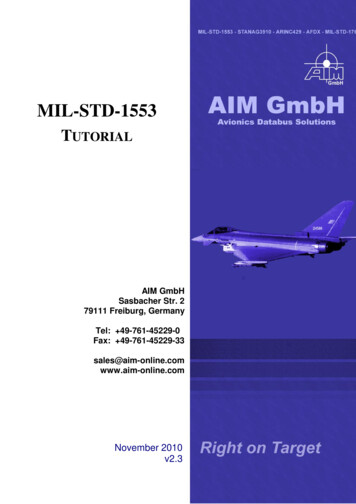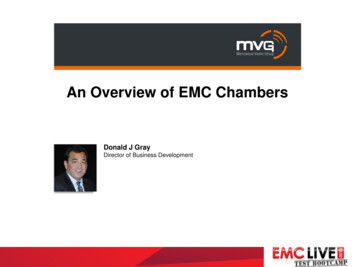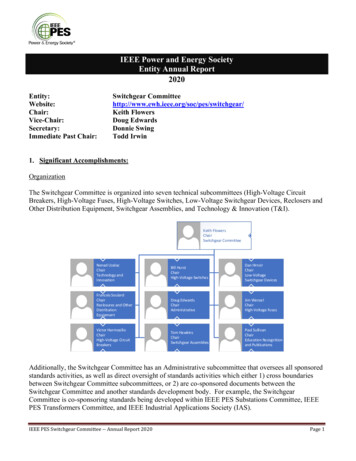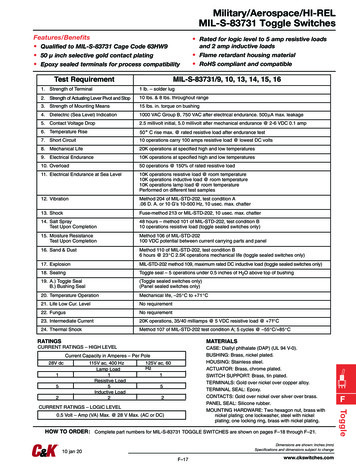
Transcription
SAMPLECONTENTSAMPLE CONTENTTarWeathering of RocksRed-orange rock fom·ati:)'l', J·:,e t1·1ei1 cclcurto high conce·1t·atIon cf 11c·1,I I, cx1 Je ·esul:eclf om cne·nca :, ea:henng cf tl,e roe-.STD. XI Sci.
TENTWritten as per the latest textbook prescribed by the Maharashtra State Bureau of TextbookProduction and Curriculum Research, Pune.PERFECTCHEMISTRY(Vol. I)COSalient FeaturesNStd. XI Sci.Written as per the new textbook Subtopic-wise segregation for powerful concept building Complete coverage of Textual Exercise Questions, Intext Questions and Numericals Extensive coverage of New Type of Questions ‘Solved Examples’ guide you through every type of problem ‘Apply Your Knowledge’ section for application of conceptsPLE ‘Quick Review’ at the end of every chapter facilitates quick revision A compilation of all ‘Important Formulae’ ‘Competitive Corner’ presents questions from prominent competitive examinations Reading Between the Lines, Enrich Your Knowledge, Gyan Guru, Connections, NCERTM SACorner are designed to impart holistic educationPrinted at: Repro India Ltd., Mumbai Target Publications Pvt. Ltd.No part of this book may be reproduced or transmitted in any form or by any means, C.D. ROM/Audio Video Cassettes or electronic, mechanicalincluding photocopying; recording or by any information storage and retrieval system without permission in writing from the Publisher.Balbharati Registration No.: 2018MH0022TEID: 13662P.O. No. 190424
PREFACE“I never teach my pupils; I only attempt to provide the conditions in which they can learn.” – Albert Einstein“Chemistry: Std. XI Volume - 1” forms a part of ‘Target Perfect Notes’ prepared as per the new textbook. Itfocuses on active learning along with making the process of education more interesting and builds up thestudents’ knowledge quotient in the process.TENTThe subtopic-wise classified format for each chapter of this book helps the students to comprehend conceptseasily. Every chapter begins with the coverage of all textual content in the format of Objectives, QuestionAnswers, Give Reasons, Numericals, Short Notes, Diagram related questions and a host of other Objective andSubjective type of questions. The questions titled under ‘Use your brain power’, ‘Can you tell’, ‘Can yourecall’, ‘Problems’ and various similar titles pave the way for a robust concept building. For thestudents to gain a better understanding of the concept lying behind the answer, ‘Reading between thelines’ (not a part of the answer) has been provided as deemed necessary. We have provided QR codesto access a video for a better understanding of the concept.Gyan Guru illustrates real lifeapplications or examples related to theconcept discussed.This is our attempt to link learning to thelife.COGG - Gyan GuruNWhile ensuring complete coverage of the syllabus in an effortless and easy to grasp format, emphasis is alsogiven on active learning. To achieve this, we have infused several sections such as, Gyan Guru, Enrich YourKnowledge, Connections, Reading between the lines and NCERT Corner, and additional sections such as,Apply Your Knowledge, Quick Review, Important Formulae, Exercise and Competitive Corner. The followingscreenshots will walk you through the core features of this book and elucidate how they have been carefullydesigned to maximize the student learning.Your weight in deep outer spaceis ZERO!!PLEThe mass of a body remainsconstant irrespective its position.However, the weight of a bodyEnrich Your KnowledgeSAMEnrich your knowledge presentsfascinating information about theconcept covered.This is our attempt to create interestwithin the students about the concept.MatterNoPure substanceConnectionsYou studied in chapter 1 oncalculating molar mass of a compound using atomicmasses of constituent elements.Can it beseparated byphysical method?YesMixtureConnections enables students tointerlink concepts covered in differentchapters.This is our attempt to enable students tocomprehend the subject as a whole.
Reading between the linesReading between the lines provides forconcept elaborationThis is our attempt to help students tounderstand the underlying conceptbehind an answer.Ostwald’s processOstwald’s process is used to prepare nitric acid on alarge scale.This method is based upon catalytic oxidation ofNH3 by atmospheric oxygen.COi.NCERT Corner covers additionalinformation from NCERT textbookrelevant to the topicThis is our attempt to bridge the gapbetween NCERT and State Board textbook,thereby helping students to prepare forNational level competitive examinations.NNCERT CornerTENTMany metals show variable oxidation numbers intheir compounds. Therefore, in their molecularformulae, the oxidation numbers are oftenrepresented by Roman numbers in parentheses afterthe chemical symbol of the metal. e.g. Au(III)Cl3,Sn(II)Cl2, Hg(II)Cl2, etc.[Note: Students can scan the adjacent QR codeto get conceptual clarity with the aid of arelevant video.]EQR code provides access to videos thatboost conceptual understanding.This is our attempt to facilitate learningwith visual aids.PLApply Your KnowledgeApply your knowledge includeschallenging questions.This is our attempt to take students onestep further and challenge theirconceptual understanding.SAMQ.73. Chalcopyrite (CuFeS2) is a common ore ofcopper. Since it has low concentration ofcopper, the ore is first concentrated throughfroth floatation process. The concentrated oreis then heated strongly with silicon dioxide(silica) and oxygen in a furnace. The productQuick review includes tables/ flow chartto summarize the key points in chapter.This is our attempt to help students toreinforce key conceptsQuick ReviewClassical theoryMatter is composed of particlesEinstein PlanckEnergy is Quantized.
Important FormulaeImportant Formulae includes all of thekey formulae in the chapter.This is our attempt to enable students tosee all the important formulae in thechapter at a glance.Celsius to Fahrenheit: F 2.3.Celsius to Kelvin: K C 273.15Average atomic mass Sumof (Isotopic mass eadditional questions and problemsThis is our attempt to provide additionalpracticequestionsthatinvolveconceptual application from the topicsacross the entire chapter.8.1Hydrogen1.Name any two isotopes of hydrogen.Ans: Refer Q. 52. (i)N2.Write the chemical equation for the preparation ofAns: Refer Q. 15.COCompetitive Corner1.TENT9( C) 3251.Which among the following is correct forelectrolysis of brine solution?[MHT CET 2019](A) Cl2 gas is liberated at cathode(B) Sodium metal is collected at anode(C) H2 gas is liberated at cathodeCompetitive Corner presents questionsfrom prominent competitive examsbased entirely on the syllabus covered inthe chapter.This is our way of providing students acompetitive edgePLEThe journey to create a complete book is strewn with triumphs, failures and near misses. If you think we’ve nearlymissed something or want to applaud us for our triumphs, we’d love to hear from you.Please write to us on: mail@targetpublications.orgA book affects eternity; one can never tell where its influence stops.Best of luck to all the aspirants!MFrom,PublisherSAEdition: FirstDisclaimerThis reference book is transformative work based on textbook Chemistry; First edition: 2019' published by the Maharashtra State Bureau of TextbookProduction and Curriculum Research, Pune. We the publishers are making this reference book which constitutes as fair use of textual contents whichare transformed by adding and elaborating, with a view to simplify the same to enable the students to understand, memorize and reproduce the same inexaminations.This work is purely inspired upon the course work as prescribed by the Maharashtra State Bureau of Textbook Production and Curriculum Research, Pune.Every care has been taken in the publication of this reference book by the Authors while creating the contents. The Authors and the Publishers shall not beresponsible for any loss or damages caused to any person on account of errors or omissions which might have crept in or disagreement of any third party onthe point of view expressed in the reference book. reserved with the Publisher for all the contents created by our Authors.No copyright is claimed in the textual contents which are presented as part of fair dealing with a view to provide best supplementary study material for thebenefit of students.
Chapter No.Chapter NameTENTCONTENTSPage No.1Some Basic Concepts of Chemistry2Introduction to Analytical Chemistry3Basic Analytical Techniques4Structure of Atom5Chemical Bonding6Redox Reactions7Modern Periodic Table2218Elements of Group 1 and Group 22539Elements of Group 13, 14 and 15288Periodic Table318Electronic Configuration of Elements3193470ECON87PLSAMNote: 1.1126173* mark represents Textual question.2.# mark represents Intext question.3. mark intext problems4. symbol represents textual questions that need external referencefor an answer
Std. XI Sci.: Perfect Chemistry ‐ I1Some Basic Concepts of Chemistry1.11.21.31.41.1IntroductionNature of chemistryProperties of matter and their measurementLaws of chemical combination1.51.61.71.8IntroductionTENTContents and ConceptsDalton’s atomic theoryAtomic and molecular massesMole concept and molar massMoles and gasesNQ.1. Define chemistry.Ans: Chemistry is the study of matter, its physical and chemical properties and the physical and chemicalchanges it undergoes under different conditions.COQ.2. Why is chemistry called a central science?Ans:i.Knowledge of chemistry is required in the studies of physics, biological sciences, applied sciences, and earthand space sciences.ii.Chemistry is involved in every aspect of day-to-day life, i.e. the air we breathe, the food we eat, the fluidswe drink, our clothing, transportation and fuel supplies, etc.Hence, chemistry is called a central science.How is chemistry traditionally classified?Chemistry is traditionally classified into five branches:Organic chemistryii.Inorganic chemistryBiochemistryv.Analytical chemistryMQ.4.Ans:i.iv.Nature of chemistryPL1.2EQ.3. Give reason: Although chemistry has ancient roots, it has developed as a modern science.Ans: Technological development in sophisticated instruments have expanded knowledge of chemistry which,now, has been used in applied sciences such as medicine, dentistry, engineering, agriculture and in dailyhome use products. Hence, due to development and advancement in science and technology, chemistry hasdeveloped as modern science.Explain the following terms:Organic chemistryii.Inorganic chemistryPhysical chemistryiii.Physical chemistryOrganic chemistry: It deals with properties and reactions of compounds of carbon.Inorganic chemistry: It deals with the study of all the compounds which are not organic.Physical chemistry: It deals with the study of properties of matter, the energy changes and the theories, lawsand principles that explain the transformation of matter from one form to another. It also provides basicframework for all the other branches of chemistry.SAQ.5.i.Ans:i.ii.iii.iii.*Q.6. Explain: Types of matter (on the basis of chemical composition)Ans: Matter on the basis of chemical composition can be classified as follows:i.Pure substances: They always have a definite chemical composition. They always have the same propertiesregardless of their origin.e.g. Pure metal, distilled water, etc.They are of two types:a.Elements: They are pure substances, which cannot be broken down into simpler substances byordinary chemical changes.1
Std. XI Sci.: Perfect Chemistry (Vol. I)Elements are further classified into three types:Metals:i.They have a lustre (a shiny appearance).ii.They conduct heat and electricity.iii. They can be drawn into wire (ductile).iv.They can be hammered into thin sheets (malleable).e.g. Gold, silver, copper, iron. Mercury is a liquid metal at room temperature.2.Nonmetals:i.They have no lustre. (except diamond, iodine)ii.They are poor conductors of heat and electricity. (except graphite)iii. They cannot be hammered into sheets or drawn into wire, because they are brittle.e.g. Iodine3.Metalloids: Some elements have properties that are intermediate between metals and nonmetals andare called metalloids or semimetals.e.g. Arsenic, silicon and germanium.b.Compounds: They are the pure substances which are made up of two or more elements in fixed proportion.e.g. Water, ammonia, methane, etc.Mixtures: They have no definite chemical composition and hence no definite properties. They can beseparated by physical methods.e.g. Paint (mixture of oils, pigment, additive), concrete (a mixture of sand, cement, water), etc.Mixtures are of two types:a.Homogeneous mixture: In homogeneous mixture, constituents remain uniformly mixed throughoutits bulk.e.g. Solution, in which solute and solvent molecules are uniformly mixed throughout its bulk.b.Heterogeneous mixture: In heterogeneous mixture, constituents are not uniformly mixed throughoutits bulk.e.g. Suspension, which contains insoluble solid in a liquid.TENT1.CONii.A rusty nailMaterialSea waterGasolineSkinA rusty nailA page of textbookDiamondPure substance or mixtureMixtureMixtureMixtureMixtureMixturePure substanceMPLNo.i.ii.iii.iv.v.vi.iv.EQ.7. Can you tell? (Textbook page no. 1)Which are mixtures and pure substances from the following?i.Sea waterii.Gasolineiii.Skinv.A page of textbookvi.DiamondAns:SAQ.8. Can you tell? (Textbook page no. 2)Classify the following as element and compound.i.Mercuric oxideii.Helium vi.vii.viii.2MaterialMercuric oxideHelium gasWaterTable saltIodineMercuryOxygenNitrogenWaterOxygenElement or entElementElementiv.Table saltviii. Nitrogen
Chapter 1: Some Basic Concepts of ChemistryGive one example of eachHomogeneous mixtureElementii.iv.Heterogeneous mixtureCompoundHomogeneous mixture: SolutionElement: Goldii.iv.Heterogeneous mixture: SuspensionCompound: Distilled waterii.Mixtures and compoundsQ.10. Distinguish betweeni.Mixtures and pure ixturesMixtures have no definite chemical composition.Mixtures have no definite properties.Pure substancesPure substances have a definite chemical composition.Pure substances always have the same propertiesregardless of their origin.Paint (mixture of oils, pigment, additive), concrete(a mixture of sand, cement, water), etc.Pure metal, distilled water, etc.MixturesMixtures have no definite chemical composition.CompoundsCompounds are made up of two or more elementsin fixed proportion.The constituents of a compound cannot be easilyseparated by physical method.Water, table salt, sugar, etc.b.e.g.The constituents of a mixture can be easilyseparated by physical method.Paint (mixture of oils, pigment, additive), concrete(a mixture of sand, cement, water), etc.COa.Nii.Q.11. What is the difference between element and compound?Ans: Elements cannot be broken down into simpler substances while compounds can be broken down into simplersubstances by chemical changes.EEnrich Your KnowledgePLNoMatterCan it beseparated byphysical method?YesPure substanceSAMNoQ.12.Ans:i.ii.iii.Can it bebroken downby a chemicalreaction?MixtureYesElementCompoundPure silverCommon saltYesIt is sTomato sauceExplain: States of matterThere are three different states of matter as follows:Solid: Particles are held tightly in perfect order. They have definite shape and volume.Liquid: Particles are close to each other but can move around within the liquid.Gas: Particles are far apart as compared to that of solid and liquid.These three states of matter can be interconverted by changing the conditions of temperature and pressure.3
Std. XI Sci.: Perfect Chemistry (Vol. I)1.3Properties of matter and their measurementTENTQ.13. Explain: Physical and chemical propertiesAns:i.Physical properties: These are properties which can be measured or observed without changing the identityor the composition of the substance.e.g. Colour, odour, melting point, boiling point, density, etc.ii.Chemical properties: These are properties in which substances undergo change in chemical composition.e.g. Coal burns in air to produce carbon dioxide, magnesium wire burns in air in the presence of oxygen toform magnesium oxide, etc.NQ.14. How are properties of matter measured?Ans:i.Measurement involves comparing a property of matter with some fixed standard which is reproducible andunchanging.ii.Properties such as mass, length, area, volume, time, etc. are quantitative in nature and can be measured.iii.A quantitative measurement is represented by a number followed by units in which it is measured.iv.These units are arbitrarily chosen on the basis of universally accepted standards.e.g. Length of class room can be expressed as 10 m. Here, 10 is the number and 'm' is the unit ‘metre’ inwhich the length is measured.COQ.15. Define: UnitsAns: The arbitrarily decided and universally accepted standards are called units.e.g. Metre (m), kilogram (kg).Q.16. What are the various systems in which units are expressed?Ans: Units are expressed in various systems like CGS (centimetre for length, gram for mass and second for time),FPS (foot, pound, second) and MKS (metre, kilogram, second) systems, etc.GG - Gyan GuruWhy are units important?PLEDuring calculations, confinement to one single system of unitis advisable. NASA’s Mars climate orbiter (first weathersatellite for mars) was destroyed due to heat. The missionfailed as there was a confusion while estimating the distancebetween earth and mars in miles and kilometres.SAMQ.17. What are SI units? Name the fundamental SI units.Ans: SI Units: In 1960, the general conference of weights and measures proposed revised metric system, calledInternational system of Units i.e. SI system (abbreviated from its French name).The seven fundamental SI units are as given below:No.i.ii.iii.iv.v.vi.vii.Base physical quantityLengthMassTimeTemperatureAmount of substanceElectric currentLuminous intensitySI olmkgsKmolAcd[Note: Units for other quantities such as speed, volume, density, etc. can be derived from fundamental SIunits.]4
Chapter 1: Some Basic Concepts of Chemistry*Q.18. What is the SI unit of amount of a substance?Ans: The SI unit for the amount of a substance is mole (mol).Q.19. What is the basic unit of mass in the SI system?Ans: The basic unit of mass in the SI system is kilogram (kg).ii.iv.vi.Full form of FPS unit systemSymbol used for Candela unitSI unit of electric currentCentimetre Gram SecondMetre (m)Kelvin (K)ii.iv.vi.Foot Pound SecondCdAmpere (A)NCERT CornerPrefixes used in the SI systemSymbolyzafpn hkMGTPEZYEGive reason: The mass of a body is more fundamental property than its weight.PLMass is an inherent property of matter and is the measure of the quantity of matter of a body.The mass of a body does not vary with respect to its position.On the other hand, the weight of a body is a result of the mass and gravitational attractionWeight varies because the gravitational attraction of the earth for a body varies with the distance from thecentre of the earth.Hence, the mass of a body is more fundamental property than its weight.GG - Gyan mtopiconanomicromillicentideciCOMultiple10 2410 2110 1810 1510 1210 910 610 310 210 1TENTName the following:Full form of CGS unit systemThe SI unit of lengthSI unit of temperatureNQ.20.i.iii.v.Ans:i.iii.v.Your weight in deep outer space is ZERO!!The mass of a body remains constant irrespective its position. However, the weight of abody depends on its position. There is less gravitational pull on moon as compared toearth. Hence, an object will have smaller weight on moon as compared to earth. There isno gravitational force in deep outer space and, so weight is ZERO!!Deep outerspaceMass: 1 kg MoonMass: 1 kgMass: 1 kgEarthWeight: 1 kgWeight: 0 kgWeight: 0.17 kg5
Std. XI Sci.: Perfect Chemistry (Vol. I)Q.22. How is gram related to the SI unit kilogram?Ans: The SI unit kilogram (kg) is related to gram (g) as 1 kg 1000 g 103 g.[Note: 'Gram' is used for weighing small quantities of chemicals in the laboratories.Other commonly used quantity is ‘milligram’. 1 mg 1000 g 106 kg]TENTQ.23. Why are fractional units of the SI units of length often used? Give two examples of the fractional unitsof length. How are they related to the SI unit of length?Ans:i.Some properties such as the atomic radius, bond length, wavelength of electromagnetic radiation, etc. arevery small and therefore, fractional units of the SI unit of length are often used to express these properties.ii.Fractional units of length: Nanometre (nm), picometre (pm), etc.iii.Nanometre (nm) and picometre (pm) are related to the SI unit of length (m) as follows:1 nm 10–9 m, 1 pm 10–12 mQ.24. Define: VolumeAns: Volume is the amount of space occupied by a three-dimensional object. It does not depend on shape.NQ.25. State the common unit used for the measurement of volume of liquids and gases.Ans: The common unit used for the measurement of volume of liquids and gases is litre (L).Enrich Your KnowledgeCOQ.26. How is the SI unit of volume expressed?Ans: The SI unit of volume is expressed as (metre)3 or m3.MPLEThe other units used to express volume are dm3, cm3, mL, etc. These units are related as follows:1 L 1 dm3 1000 mL 1000 cm31000 cm3 10 cm 10 cm 10 cm of volumeVolume: 1000 cm3 1000 mLVolume: 1 cm3 1 mLSA1 cmQ.27.Ans:i.ii.iii.10 cm 1dm1 cmName some glassware that are used to measure the volume of liquids and solutions.Graduated cylinderBurettePipetteQ.28. What is a volumetric flask used for in laboratory?Ans: A volumetric flask is used to prepare a known volume of a solution in laboratory.6
Chapter 1: Some Basic Concepts of ChemistryEnrich Your KnowledgeCalibrationmark indicates25-mL volumemL01234Valve(stopcock)Controls theliquid flow100-mLgraduated cylinder4445464748495025-mL pipette50-mL burette250-mLvolumetric flaskWhat is density of a substance? How is it measured?Density:Density of a substance is its mass per unit volume. It is the characteristic property of any substance.It is determined in the laboratory by measuring both the mass and the volume of a sample.The density is calculated by dividing mass by volume.NQ.29.Ans:i.ii.iii.Calibrationmark indicates250-mL volumeTENTThe calibration of volumetric glassapparatus is shown in the figures given.SI unit massSI unit volumekg 3mDensity gor g mL–1.]mLEii. kg m–3CGS unit of density: g cm–3COQ.30. How is the SI unit of density derived? State CGS unit of density.Ans:i.The SI unit of density is derived as follows:[Note: The CGS unit, g cm–3 is equivalent toPLQ.31. State three common scales of temperature measurement.Ans:i.Degree Celsius ( C)ii.Degree Fahrenheit ( F)iii.Kelvin (K)MQ.32. State the temperatures in Fahrenheit scale that corresponds to 0 C and 100 C.Ans: The temperature that corresponds to 0 C is 32 F and the temperature that corresponds to 100 C is 212 F.Enrich Your KnowledgeSAThermometers of different temperature scales:Generally, the thermometer with Celsius scale arecalibrated from 0 C to 100 C where these twotemperatures are respectively the freezing point and theboiling point of water at atmospheric pressure. Humanbody temperature is 37 C.KelvinCelsius Fahrenheit7
Std. XI Sci.: Perfect Chemistry (Vol. I)Q.33. Write the expression showing the relationship between:i.Degree Fahrenheit and Degree Celsiusii.Kelvin and Degree CelsiusAns:i.The relationship between degree Fahrenheit and degree Celsius is expressed as, F The relationship between Kelvin and degree Celsius is expressed as,K C 273.15TENTii.9( C) 325Solved Examples*Q.34. Convert the following degree Celsius temperature to degree Fahrenheit.i.40 Cii.30 CSolution:i.Given:Temperature in degree Celsius 40 CTo find:Temperature in degree Fahrenheit F 9( C) 325Calculation: Substituting 40 C in the formula,9( C) 3259 (40) 325ii.CO F NFormula:Given:To find: 72 32 104 FTemperature in degree Celsius 30 CTemperature in degree FahrenheitFormula: F 9( C) 325ECalculation: Substituting 30 C in the formula,9( C) 3259 (30) 325PL F 54 32 86 FAns: i. The temperature 40 C corresponds to 104 F.ii. The temperature 30 C corresponds to 86 F.SAMQ.35. Convert the following degree Fahrenheit temperature to degree Celsius.i.50 Fii.10 FSolution:i.Given:Temperature in degree Fahrenheit 50 FTo find:Temperature in degree CelsiusFormula: F 9( C) 325Calculation: Substituting 50 F in the formula,9( C) 325950 ( C) 325 50 – 32 5 C 9 F 10 C8
Chapter 1: Some Basic Concepts of Chemistryii.Given:To find:Temperature in degree Fahrenheit 10 FTemperature in degree CelsiusFormula: F 95( C) 32Calculation: Substituting 10 F in the formula,9( C) 325910 ( C) 32510 – 32 5 C 9TENT F –12.2 CAns: i. The temperature 50 F corresponds to 10 C.ii. The temperature 10 F corresponds to –12.2 C.1.4 Laws of chemical combinationCONQ.36. What is a chemical combination?Ans:i.The process in which the elements combine with each other to form compounds is called chemicalcombination.ii.The process of chemical combination is governed by five basic laws which were discovered before theknowledge of molecular formulae.State and explain the law of definite proportions.Law of definite proportions:The law states that “A given compound always contains exactly the same proportion of elements by weight”.French chemist, Joseph Proust worked with two samples of cupric carbonate; one of which was naturallyoccurring cupric carbonate and other was synthetic sample. He found the composition of elements present inboth the samples was same as shown below:SAMQ.38.Ans:i.ii.PLE*Q.37. State and explain the law of conservation of mass.Ans: Law of conservation of mass:i.The law of conservation of mass states that, “Mass can neither be created nor destroyed” during chemicalcombination of matter.ii.Antoine Lavoisier who is often referred to as the father of modern chemistry performed careful experimentalstudies for various combustion reactions, namely burning of phosphorus and mercury in the presence of air.iii.Both his experiments resulted in increased weight of products.iv.After several experiments, in burning of phosphorus, he found that the weight gained by the phosphorus wasexactly the same as the weight lost by the air. Hence, total mass of reactants total mass of products.v.When hydrogen gas burns and combines with oxygen to form water, the mass of the water formed is equal tothe mass of the hydrogen and oxygen consumed. Thus, this is in accordance with the law of conservation ofmass.Cupric carbonateNatural sampleSynthetic sampleiii.% of copper51.3551.35% of carbon9.749.74% of oxygen38.9138.91Thus, irrespective of the source, a given compound always contains same elements in the same proportion.Reading between the linesThe validity of this law has been further supported by various experiments. This law is often called as Law ofdefinite composition.9
Std. XI Sci.: Perfect Chemistry (Vol. I)Enrich Your KnowledgeTENTThe law of definite composition is not true for all types of compounds. It is true for only those compoundswhich are obtained from one type of isotope.e.g. Carbon exists in two common isotopes: 12C and 14C. When it forms 12CO2, the ratio of masses is 12:32 or3:8. However, when it is formed from 14C i.e., 14CO2, the ratio will be 14:32 i.e., 7:16, which is not sameas in the first case.*Q.39. State the law of multiple proportions.Ans: The law states that, “When two elements A and B form more than one compounds, the masses of element Bthat combine with a given mass of A are always in the ratio of small whole numbers”.State and explain the law of multiple proportions.Law of multiple proportions:John Dalton (British scientist) proposed the law of multiple proportions in 1803.It has been observed that two or more elements may combine to form more than one compound.The law states that, “When two elements A and B form more than one compounds, the masses of element Bthat combine with a given mass of A are always in the ratio of small whole numbers”.e.g. Hydrogen and oxygen combine to form two compounds, water and hydrogen peroxide.NQ.40.Ans:i.ii.iii.Hydrogen Oxygen Water2g16 g18 g32 g2gCOHydrogen Oxygen Hydrogen peroxide34 gHere, the two masses of oxygen (16 g and 32 g) which combine with the fixed mass of hydrogen (2 g) inthese two compounds bear a simple ratio of small whole numbers, i.e. 16:32 or 1:2.Q.41. Verify the law of multiple proportions for the chemical reaction between nitrogen and oxygen.Ans: Nitrogen and oxygen combine to form two compounds, nitric oxide and nitrogen dioxide.Nitrogen Oxygen Nitric oxide14 g16 g14 g32 g30 gENitrogen Oxygen Nitrogen dioxide46 gPLHere, the two masses of oxygen (16 g and 32 g) which combine with the fixed mass of nitrogen (14 g) inthese two compounds bear a simple ratio of small whole numbers, i.e. 16:32 or 1:2.This is in accordance with the law of multiple proportions.MQ.42. Verify the law of multiple proportions for the chemical reaction between carbon and oxygen.Ans: Chemical reaction of carbon with oxygen gives two compounds, carbon monoxide (CO) and carbon dioxide(CO2).Carbon Oxygen Carbon monoxide12 g28 g16 gCarbon Oxygen Carbon dioxideSA12 g32 g44 gHere, the two masses of oxygen (16 g and 32 g) which combine with the fixed mass of carbon (12 g) in thesetwo compounds bear a simple ratio of small whole numbers, i.e. 16:32 or 1:2.This is in accordance with the law of multiple proportions.Q.43. Verify the law of multiple proportions for the chemical reaction between sulphur and oxygen.Ans: Ch
Physical chemistry iv. Biochemistry v. Analytical chemistry Q.5. Explain the following terms: i. Organic chemistry ii. Inorganic chemistry iii. Physical chemistry Ans: i. Organic chemistry: It deals with properties and reactions of compounds of carbon. ii. Inorganic chemistry: It deals with the study of all the compounds which are not organic. iii.











